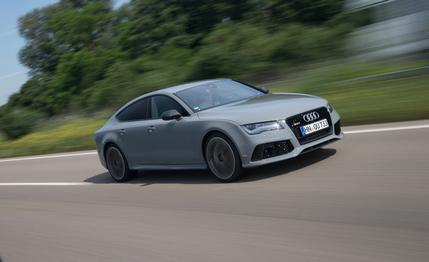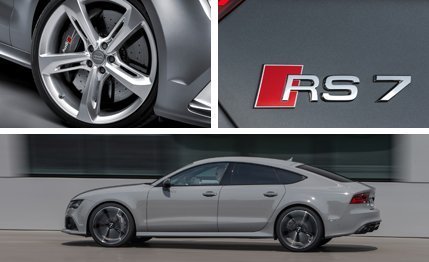
 First Drive Review
First Drive Review
Yes, it’s real. The engineers at Quattro in Neckarsulm, Germany, have slotted a ridiculously powerful, twin-turbocharged V-8 into the Audi A7 and birthed nothing less than a five-door supercar. That model, the RS7, will bully its way onto American shores later this year, with its blacked-out, single-frame grille and gaping intakes pointed squarely at the BMW M6 Gran Coupe, Mercedes-Benz CLS63 AMG, and Cadillac CTS-V. All have more than 550 horsepower. The BMW and the Cadillac are rear-wheel drive; the Mercedes-AMG and the Audi offer all-wheel-drive solutions.
The RS7 shares its twin-turbo 4.0-liter V-8 with the one-rung-down S7, where the engine kicks out a still-impressive 420 horsepower and 406 lb-ft of torque. To arrive at RS7 output, however, add 100 to each figure—and then some. Maximum horsepower is 553 at 5700 rpm, and the max torque figure of 516 lb-ft is available on a long plateau stretching from 1750 to 5500 rpm. (The RS7’s engine is also available in the lustworthy, not-for-the-U.S. RS6 Avant.)
Audi claims a 0-to-60-mph time of just under four seconds, but we figure a time in the mid-threes is possible; we recorded a 3.7-second blast from the S7’s S6 twin in a recent comparison test. In Europe, the RS7’s top speed is governed at 155 mph, 174 mph, or 190 mph, depending on the option package selected. Unrestricted, we’re told the RS7 could sniff 200 mph, although the 10 additional mph would require running very high tire pressures, which would degrade available grip. In any event, 190 mph is plenty, and the RS7 gets there in a hurry.


The less-powerful S7 uses Audi’s own seven-speed dual-clutch automatic, but that gearbox can’t handle any more twist, so the RS7 is fitted with the ubiquitous ZF-sourced eight-speed torque-converter automatic. Considering that box’s conventional design, we found it provides quick automatic up- and downshifts and is smooth in operation. But it leaves a bit to be desired in the manual shifting mode. We had to train ourselves to tap the upshift paddle well in advance of the redline; otherwise, the responses weren’t quick enough to prevent running into the limiter.
The RS7 offers the driver multiple driving modes, the hardest core of which is Dynamic. It sharpens the engine and chassis responses of this large hatchback to a razor’s edge. A gentle stroke of the gas pedal sends the RS7 deep into triple-digit territory, and despite a 4500-ish-pound curb weight, the chassis is athletic and the responses quick. That goes double for examples spec’d like our test car, which included an optional sport differential with torque-vectoring functionality, gummy 275/30 tires on 21-inch wheels, and RS Sport Suspension Plus. This steel-intensive setup incorporates diagonally opposed dampers connected by hydraulic lines and controlled by a central valve; it responds immediately to cornering forces and virtually eliminates body roll. The RS7 is available with an adaptive air suspension that is more comfortable, but its compliance comes at the expense of ultimate handling.
The RS7 is opulently equipped and spacious inside, and the versatile hatch is eminently practical. If even more cargo space were a requirement, however, one might instead consider the slightly crude but cheaper CTS-V wagon—it’s entering its final model year—or the special-order-only E63 AMG wagon. If pressed to identify demerits in the RS7, the integration of the head-up display looks like an afterthought and is a bit of an eyesore in an otherwise beautiful interior. But that quibble does nothing to diminish the experience. The RS7 is a hellacious beast, and we’re glad a large, high-powered RS car will once again prowl U.S. streets.